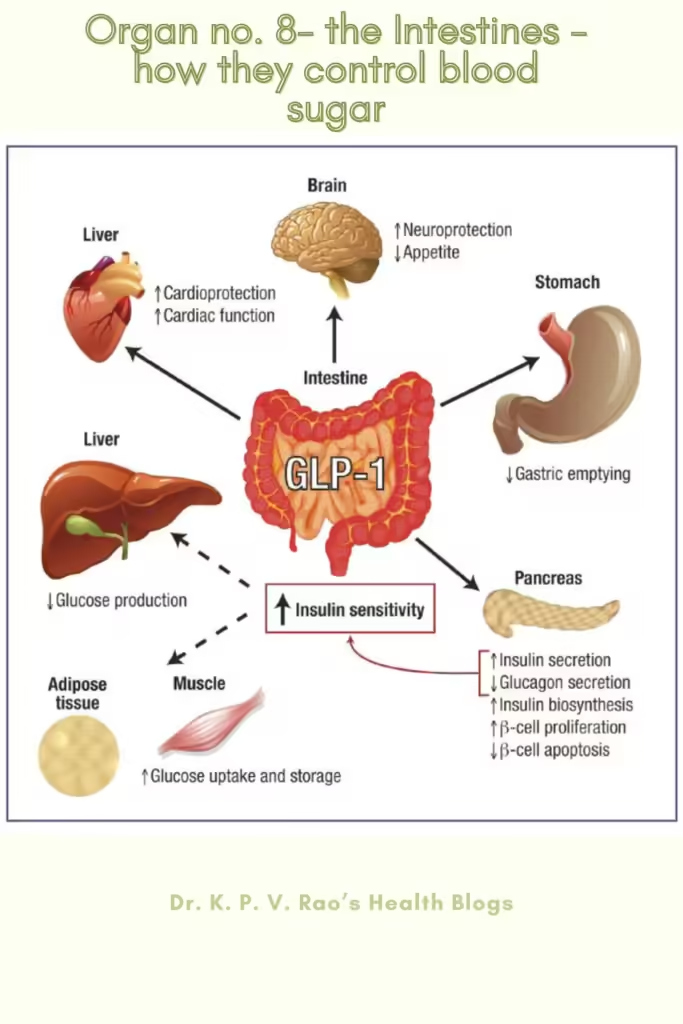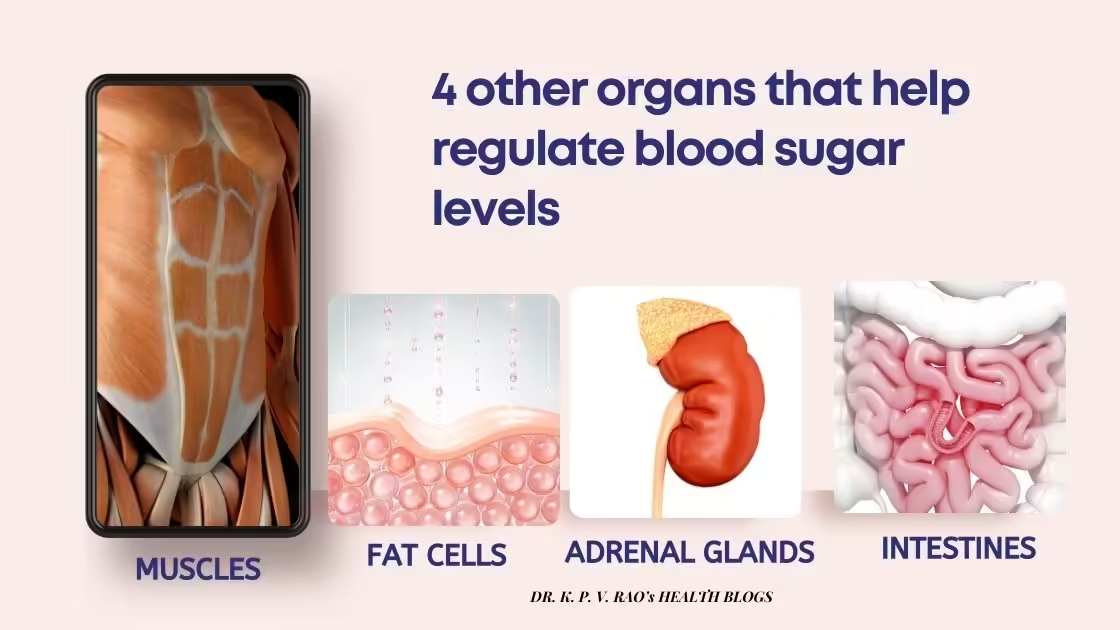In my last post on this topic, I discussed 4 organs that help manage blood sugar. In this article, we discuss 4 more such organs, making it overall 8 organs that help regulate blood sugar. If you have not read it, you can do so here-
The Muscles-Organ no.5 of the Organs that help regulate blood sugar:
Glucose Uptake and Utilization
The muscles play a crucial role in the regulation of blood sugar levels through their ability to uptake and utilize glucose, particularly during physical activity.
When the body engages in exercise, muscle cells become more receptive to glucose, drawing it from the bloodstream to use as a primary energy source.

This process is mediated by the action of insulin, a hormone that facilitates the entry of glucose into cells. Consequently, Regular physical activity can significantly aid in maintaining optimal blood sugar levels by enhancing the muscles’ glucose uptake capabilities.
How do the muscles do it?
During periods of physical exertion, the increased demand for energy leads to a higher rate of glucose utilization within muscle cells. This not only helps in managing blood sugar levels but also contributes to the overall metabolic health of an individual. The muscles’ ability to efficiently use glucose is a critical factor in preventing hyperglycemia, a condition characterized by elevated blood sugar levels.
However, reduced physical activity can impair this glucose uptake process. In sedentary individuals, the muscles’ sensitivity to insulin diminishes, making it more challenging for glucose to enter the cells. This condition, known as insulin resistance, is a significant contributor to hyperglycemia.
When muscle cells become resistant to insulin, glucose remains in the bloodstream, leading to elevated blood sugar levels. Insulin resistance in muscle tissue is commonly associated with various metabolic disorders, including type 2 diabetes.
This article from American Diabetes Association will explain how muscles and exercise help regulate blood sugar levels-
Physical Activity/Exercise and Type 2 Diabetes
Moreover, muscle mass itself plays a role in glucose metabolism. Greater muscle mass can enhance the body’s ability to regulate blood sugar levels due to a higher capacity for glucose uptake and storage.
Conversely, a decrease in muscle mass, often seen with aging or lack of physical activity, can exacerbate the risk of hyperglycemia.
Therefore, maintaining muscle health through regular exercise is essential for effective glucose regulation and prevention of hyperglycemia.
Organ no. 6-The Fat Cells or Adipose tissue
Lipolysis and Insulin Resistance
Fat cells, also known as adipocytes, play a crucial role in the body’s energy storage and release. These cells store excess energy in the form of triglycerides, which can be broken down into fatty acids and glycerol through a process called lipolysis. During periods of energy demand, lipolysis enables the release of these stored fatty acids into the bloodstream, providing necessary fuel for various tissues.
However, the functionality of fat cells extends beyond simple energy storage and release. Excessive fat accumulation, often due to overnutrition or sedentary lifestyle, can lead to a state known as obesity. In this condition, the fat cells become hypertrophic and hyperplastic, meaning they enlarge and increase in number. This excessive fat storage can disrupt normal metabolic processes and contribute to the development of insulin resistance.

Furthermore, hypertrophic fat cells can secrete various pro-inflammatory cytokines and adipokines, which exacerbate insulin resistance. These bioactive molecules interfere with insulin signaling pathways, further impairing glucose metabolism and contributing to systemic inflammation. The combination of increased lipolysis and impaired insulin action creates a vicious cycle that perpetuates elevated blood sugar levels.
Summary
Understanding the role of fat cells in energy balance and insulin resistance highlights the importance of maintaining a healthy weight and lifestyle to prevent hyperglycemia.
Effective management of fat storage and metabolic health can significantly impact the regulation of blood sugar levels and overcome the risk of developing diabetes and other related complications.
The Adrenal Glands: Stress Hormones and Blood Sugar
The adrenal glands, small but powerful organs located atop each kidney, play a crucial role in the body’s response to stress. These glands produce a variety of hormones, including cortisol and adrenaline, which are integral to managing the body’s stress response.
When an individual encounters a stressful situation, the adrenal glands release these hormones to prepare the body for a “fight or flight” response. This mechanism involves increasing the availability of glucose in the bloodstream to provide immediate energy for muscle activity.
Cortisol, often referred to as the “stress hormone,” has a significant impact on blood sugar levels. Under stress, cortisol prompts the liver to release stored glucose, thereby increasing blood sugar. This process ensures that sufficient energy is available to deal with the perceived threat.
Similarly, adrenaline, another hormone produced by the adrenal glands, enhances the breakdown of glycogen to glucose, further elevating blood sugar levels.
While these responses are beneficial in acute stress situations, chronic stress can lead to prolonged periods of elevated blood sugar. When the body is under constant stress, the adrenal glands continue to secrete cortisol and adrenaline, leading to sustained hyperglycemia.
Chronic hyperglycemia can have detrimental effects on various systems within the body, contributing to conditions such as insulin resistance and type 2 diabetes.
Additionally, the continuous demand for glucose can strain the pancreas, which is responsible for producing insulin to regulate blood sugar levels. Over time, this excessive demand can impair the pancreas’s ability to function effectively, exacerbating hyperglycemia.
Summary
Managing stress is essential for maintaining healthy blood sugar levels. Techniques such as mindfulness, regular physical activity, and adequate sleep can help mitigate the adverse effects of stress on the adrenal glands and, consequently, on blood sugar regulation.
By understanding and addressing the role of the adrenal glands in stress and blood sugar management, individuals can take proactive steps to prevent chronic hyperglycemia and its associated health risks.
Organ no. 8 of Organs that help regulate blood sugar- The Intestines
The intestines play a minor but important role in managing blood sugar levels. With the help of a hormone called incretins, this organ does this job to help other organs do their job.
Incretins help regulate blood sugar levels by stimulating insulin secretion and reducing glucagon release from the pancreas. This leads to increased glucose uptake by cells and decreased glucose production by the liver, resulting in lower blood sugar levels.
The intestines produce hormones known as Glucagon-like peptide 1 (GLP-1) and glucose-dependent insulinotropic polypeptide (GIP) that are released in response to food intake and its presence in the GI tract.
The image below explains how the incretin hormones from the gastrointestinal tract help regulate blood sugar.

Incretin hormones, such as GLP-1 (glucagon-like peptide-1) and GIP (glucose-dependent insulinotropic polypeptide), play a role in regulating blood sugar levels in the intestines. They are released in response to the presence of food in the digestive system.
Summary
Incretins stimulate insulin secretion from pancreatic beta cells and inhibit glucagon release from alpha cells, both of which help lower blood sugar levels.
Additionally, as shown in the picture above, incretins slow down gastric emptying, reduces appetite, and enhances satiety [feeling of fullness of stomach], which further contributes to blood sugar regulation.
Conclusion
Here we end our discussion about all the organs that help regulate blood sugar. If you have any queries, you can put it down in the comments box- I will surely respond to it.
If you have found these two articles on regulation of blood sugar, I would be happy if you could share it with your friends and relatives on social media platforms at the end of this article. You can also Click to Tweet below-
Organs that help regulate blood sugar (contd.) Share on XAdios.

